The half rest is another musical symbol that is used to represent silence in a piece of music. It usually sits between music notes, and tells the musician at what point in the music they should stop playing.
This rest can be very easily confused with a whole rest. It is almost identical to it in the way it looks, but is used very differently.
The half is held out for 2 beats, while the whole is held out for an entire four beats. The whole rest represents silence over the entire measure and is used less frequently then the half.
Let’s jump right in, and see how this rest is applied to music notation. Where and how to use it, and how tell it apart from all the other rests there are out there.
Here It Is!
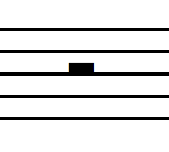
The half rest looks like a small block that is growing up out of the staff lines.
The position of the rest is always on the third (middle) line. It points in an upward direction, and goes about half-way up the third space.
It always sits in the measure with other notes or rests. And it will take up about one half of the measure. This is a good way of telling how long to hold it out.
Duration
This rest is held out for two beats, or half of the measure.
Most songs are in four four time. This means that there are four beats in each measure. If there are four beats to each measure, and this rest takes up half of the measure, that means that it is worth two beats.
When you see a rest it is telling you that at this point you are to stop playing. It doesn’t mean that you keep holding the previous note. You are to completely take your hands off the piano.

Take a look at the rest along with some other notes. You can see how the measure takes up about half of the measure and the notes take up the other half of the measure.
This is a good way to visually tell how long to hold out the rest. You can see in the measure that there are no notes there, so you know not to play.
Looking Up?
The half rest and whole rest are almost identical to each other.
The best way to tell the difference between them is to look at the direction the rest is pointing. A half rest will always point upward, and a whole rest will always point downward.
Another difference between the two is that whole rest sits on the fourth line up, or second line down. This makes both of the rests fall on the third space in the staff. In the treble clef, this would be a C note.
Take a look at the image below and see the difference between the two rests.
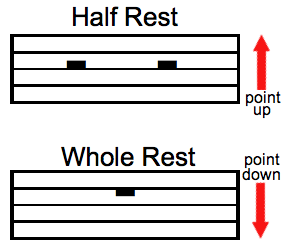
Not only does one point up and one point down, but they both take up different amounts of space in the measure. In the image you can see how the whole rest sits perfectly in the center of the measure. This is helpful to know that there will be silence for the whole measure.
The half rest will never sit in the center of the measure like a whole rest. This is a great way of telling the difference in the two
Recap – Difference in Half and Whole Rest
- Half points up – whole points down
- Half is on the third line – whole is on the fourth line
- Whole takes up the whole measure – half doesn’t
Half Rest and Half Notes
Just like all the other rests, there is a note that has equal value to it. The half note has the same value as the rest.
Since we know that a half rest is held for two beats, then a half note is held out for two beats.
If you look at one measure of music, there is four beats in each measure. This means that there will be two half notes and rests in that measure. Two beats for the first, and two beats for the second.

Each of them both take up half of the measure, giving each of them two beats
Look at the image and see how half notes and rests are similar to each other.
Practice
Let’s take a minute and practice counting rests. When you count these measures below, when you get to the rest say “Off” to tell yourself to stop playing.
Let’s Go!
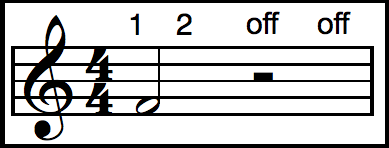
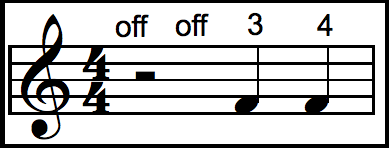
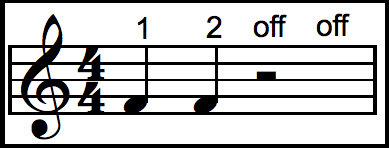
The half rest can very easily be confused with a whole rest. Make sure that you look at the direction of the rest and where it sits in the measure to help you remember its value.
Practice counting rests and note values everyday when you are first learning them. This will make it almost second nature when you really start to learn to play.

